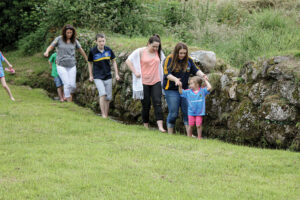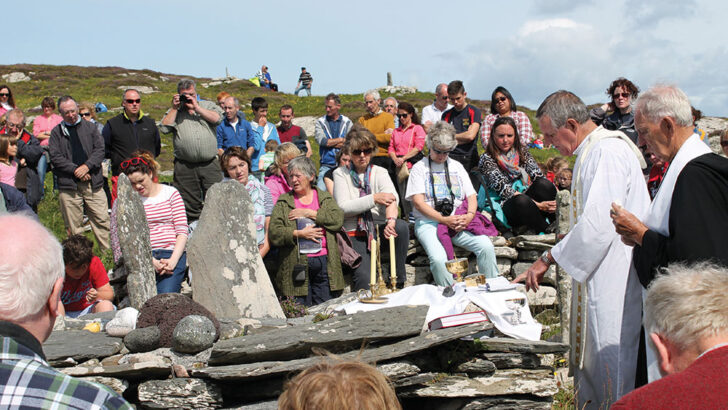Ava Westendorf

According to a survey that the magazine National Geographic conducted, in 2023, over half a million people went on the pilgrimage of Camino de Santiago in Galicia, Spain. However, only 40% of these walkers were using this route for religious reasons. Due to an influx of fitness trends and people’s increased love for traveling, these spiritual paths are gaining popularity from people who are not using them for their originally intended purposes. However, lacking the religious context, the people using these paths for physical activity are both looking for the same end goal: an improvement of health.
Author of Journeys of Faith: Stories of Pilgrimage from Medieval Ireland (Columba Books, 2021), PhD student and researcher of medieval pilgrimages, Louise Nugent, told The Irish Catholic about the original meaning of pilgrimages. There are three key reasons that Dr Nugent listed: belief in the power of Saints, imposition as a tenant and indulgences.
Power of Saints
One of the initial reasons for pilgrimages was said to be people’s beliefs in the Saint’s to “intercede with God” and heal the believer or one of their family members. Dr Nugent said that this reason is “central to most pilgrimages” and people would travel to “either the grave of the Saints or the relics of the Saints” to pray in the hope of healing or creating a cure. Dr Nugent said that in some cases, she has traveled to pilgrimages and seen images or relics, such as a picture of a baby in an incubator or an inhaler that people left behind at the site of the Saints, in hopes that these issues would soon be cured. This is still a common pilgrimage reason that is still used today.
Imposition as a Tenant
During medieval pilgrimages, people were also sent on these long paths because “they would be atoning for sins and they would be given a set number of places to visit” before they could be pay off their debts. Depending on the sin that needed to be forgiven, the walker may have multiple sites to visit or just a small amount. Dr Nugent gave an example of this type of reasoning. “There is one Irishman in the mid 16th century who was given a pilgrimage of almost 20 sites all around Ireland that he had to visit, and he was sent to his home for the end of it. He basically murdered his sons, so this was a kind of a means for him to atone in some way.” This man, whose name was Heneas Mac Nichaill, atoned for his sins along nineteen pilgrimage sites around Ireland in 1543. Although this reason for pilgrimages was popular with many, it is not as commonly used in modern times.
Indulgences

The final reason given for medieval pilgrimages was indulgences. Dr Nugent says that “because there is social aspects as well in the pilgrimage,” people will often have gone on these pilgrimages to indulge in their own personal desires. They could take the time during the long journey to speak to friends or family instead of focusing on the destination ahead. Many others would go on these pilgrimages in need of a break from their lives, so they would use this walk for peace and quiet. This aspect of medieval pilgrimages, although religious, seems to correlate with many of the reasons people are going on modern pilgrimages with a secular mindset.
Kimberley Davis, a 35-year-old marathon runner from Toronto, told National Geographic that these pilgrimages are “this bubble of peace. No obligations, no planning, no looking for hotels or restaurants, and I loved being outside for six weeks, which I think is really healthy.” These six weeks were spent walking “the 480-mile-long Camino Frances from Saint-Jean-Pied-de-Port through the French Pyrenees to the city of Santiago de Compostela in Spain.” As well as with the reasoning of indulgences in medieval pilgrimages, Kimberly Davis was pursuing her journey to find peace from her stressful life.
Meaning of the Path
No matter why people take these journeys, it does not change what the ending of the pilgrimage means to them. In a medieval pilgrimage, it was more likely that, especially for health reasons as Dr Nugent said, the believers were more interested in the shrines or religious graves they would see at the end of their journey. For many taking these more modernised pilgrimages where religion is not the sole factor, they are more interested in the physical exertion and destination of the journey.
Nicole Hu, a 27-year-old from Chicago, told National Geographic that her 75 miles walking the Camino de Santiago in Spain was “hard on the body, but it is a really good discipline. I think I’d do it again, but for longer, just because I think you would get more out of it.” Although exhausting, it was a rewarding experience for her since she was able to get physical strength out of this journey as well as be in a beautiful place.
You can exercise anyplace, but it’s very special to do it in a place as unique as Japan while participating in a curated cultural journey”
In terms of partaking in these journeys for beauty, many people also like to immerse themselves in a certain culture without being a part of that religious lifestyle themselves. Rick Walsh, a 63-year-old from San Franciso walked the six-day Shikoku Wayfarer Tour in Japan and told National Geographic that “you can exercise anyplace, but it’s very special to do it in a place as unique as Japan while participating in a curated cultural journey.” Mr Walsh found this pilgrimage to be special because he got to do it in a foreign place while also immersing himself with the beauty of Japanese temples and history. He is obtaining second-hand experiences with the religion that leads many to take this path to visit the 88-temples that line this pilgrimage.
Gaining Popularity
This idea to hike the pilgrimages without a religious intent began to increase in popularity when the Covid-19 virus kept people from around the world in quarantine. During this time, people were struggling with the fact that they could not gain physical activity by going outside like they used to. Without this ability to get fresh air whenever they wanted, they looked for other ways to retrieve an adventure from inside of the safety of their home. This is when the popular trend and website ‘The Conqueror Virtual Challenges’ began to immerge.
The company’s CEO Adam El-Agnez, began his adult career as a Physical Education Teacher in New Zealand. From this job he learned that he enjoyed helping people build on their fitness goals, seeing them grow happy and healthy. Through this, he started ‘The Conqueror Virtual Challenges’ in 2013 so he could help inspire those of all ages, virtually. Although it was created before the Covid-19 virus, this epidemic helped it gain popularity. People, stuck inside their houses, now had the ability to walk through fictional worlds and abroad adventures online. As a reward for working out within their home, users of this website were sent a medal, such as one given at the end of a marathon.
People were not seeing the true religious side of this journey, instead just seeing the fitness goal”
When this website was started, the hikes were spots that were based on journeys in fantasy novels or very popular places that people dreamt of going. After a few months, the website began adding in pilgrimages, their most popular being the Camino de Santiago in Spain. Through this virtual trail, people were not seeing the true religious side of this journey, instead just seeing the fitness goals that, in the end, led to a reward. Now that the Covid-19 pandemic is mostly in the past, the people that once used this virtual fitness challenge to complete these pilgrimages, without religious reasons, are now going to these sites in person.
Health
While this trend does not include religion as one of its main purposes, it does hold the same overall reason: health. For people allowing faith to lead their journey, they are normally looking for the healing of a family member or themselves. In comparison, people who are using these paths with secular intent, are using them to better their own physical and mental health. Marc Massad, a personal trainer based in the U.K. told National Geographic that “walking boosts cardiovascular health, promotes weight loss, improves balance and coordination, and enhances muscle endurance with minimal joint strain,” and that it “also has profound mental health benefits. It’s a natural stress reliever releasing endorphins that can decrease symptoms of depression and anxiety.” The use of walking these paths in making people happier and healthier, one of the key goals that walking pilgrimages for religious reasons also obtain.
The question of faith vs fitness is a difficult question to answer since there is not a definite definition of a pilgrimage. Dr Nugent told The Irish Catholic that a “pilgrimage is quite broad, and it covers a big spectrum of types of pilgrimage and types of sites”. They often range in mileage and the number of landmarks that can be seen during the journey, both factors of which can deter a person’s reasoning for going on such a pilgrimage. Dr Nugent directly mentioned the Knock Pilgrimage when describing the different types of pilgrimages that one can embark since it is so short and often changes the purpose of the journey.
Dr Nugent also said the purposes of pilgrimages can be quite complex to figure out. Some people may embark on a journey without having any religious reason, but they still hold a spiritual reason for going along the path. In another article that National Geographic wrote in 2021 called ‘Could pilgrimages be the next post-pandemic trend’, photographer Tim Bird said that his journey was “meditative and spiritual, but not in a prescribed religious way”. In 2019 Mr Bird cycled St Olav Waterway, a pilgrim trail linking Finland and Sweden. He enjoyed the peace that seeing the earth and animals gave him without having a religious connection to the path he was taking.
If you are gaining health from your journey, then you can embark on a pilgrimage”
Guy Howard, co-founder of the company British Pilgrimage Trust as well as the co-author of Britain’s Pilgrim Places, says that it is okay to embark on a pilgrimage without religious intent. He claims that “there’s nothing intrinsically religious or secular about connecting with your deepest needs,” and that “the word ‘holy’ comes from the Old English ‘halig’, meaning ‘bringing health’.” Therefore, if you are gaining health from your journey, then you can embark on a pilgrimage. In fact, the British Pilgrimage Trust reported that when their customers were asked about what motivates them to go on these journeys, only 13% of the quotes mentioned a religious observation, while everyone else wrote about their mental health, connecting with nature and learning about their spiritual and cultural heritage.
Compatibility
So, are fitness and faith able to work side by side? Many dioceses around Ireland such as the Diocese of Achonry seem to think so. On June 9, 2024, the diocese held an Achonry Reek Challenge where they used the idea of a hike to create a gathering at their diocese. They are using the idea of getting physically fit and mentally healthy through a hike to draw people to their faith.
The Christ Church Parish also had this same idea with their ‘Fitness and Faith’ event on the 3, 7 and 17 of June. For these events, they invite all the parish ladies to join them on a walk or run followed by a dinner. Whether people agree with it or not, it seems that fitness and faith are beginning to work together in both pilgrimages and at common events in someone’s parish.
So, was National Geographic wrong to say that people are using pilgrimages without faith and are these two features able to work together? Guy Heyward thinks that this new popularity for pilgrimages is a positive but that some people are not as accepting of this secular viewpoint, “there are obviously hardcore people who believe there is only one way of doing a pilgrimage, and it has to be highly devotional.” Although there are these views, he hopes that people will realise that pilgrimages can become a sort of side door for people to encounter deeper aspects of themselves,” and that health needs to be priortised over religion in these experiences.


 - Early medieval leacht at Caher Island Co. Mayo, used as an altar during the patron day Mass in 2016.
- Early medieval leacht at Caher Island Co. Mayo, used as an altar during the patron day Mass in 2016.